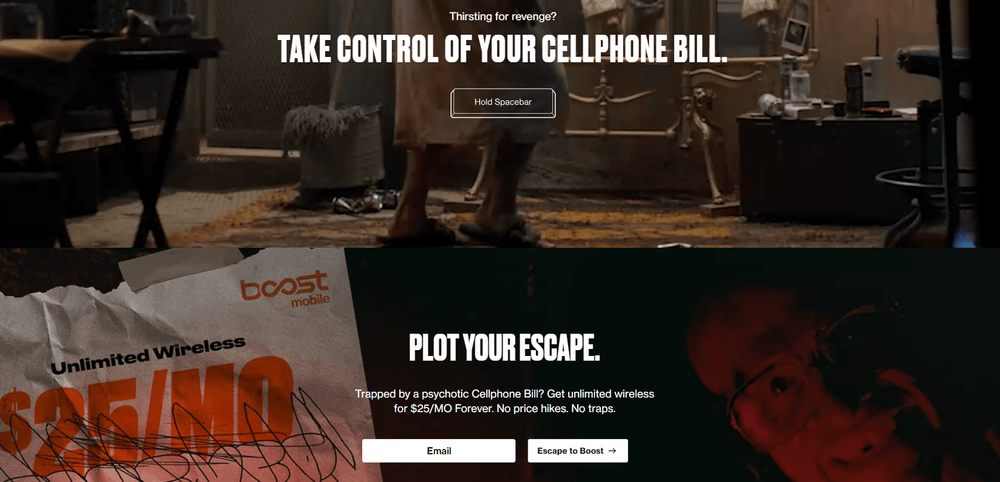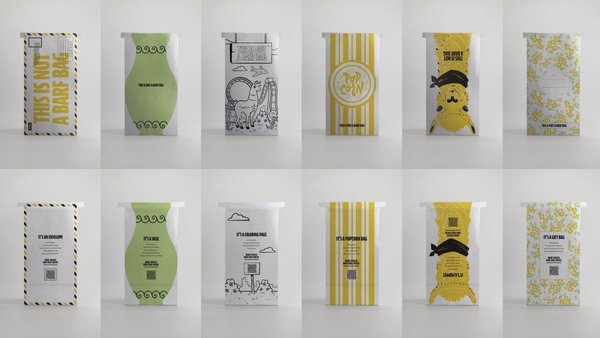Campaign of the Week
Boost Mobile and Liquid Death turn a phone bill into horror-comedy creative /
Telco and canned water brand drop horror-comedy campaign skewering wireless contracts in a refreshingly strange collab
In September 2025, US mobile network operator Boost Mobile teamed up with Liquid Death to launch Cellphone Bill, a horror-comedy campaign turning hidden fees, confusing terms and sudden price hikes into a cinematic villain.

Actor and comedian Tony Cavalero (from TV show The Righteous Gemstones) stars as Cellphone Bill, a psychotic figure who terrorises families in scenes inspired by cult horror films – dangling phones over victims and whispering menacing warnings about fees and fine print. While Liquid Death isn’t mentioned by the characters, Cellphone Bill drinks the brand’s water and douses a victim with it in homage to The Silence of the Lambs.
The campaign featured two primary spots created by Liquid Death’s in-house studio, Death Machine, and ran across digital channels, social platforms and a dedicated website, CellphoneBill.com. There, viewers were invited to ‘escape’ by switching to Boost Mobile’s $25/month Unlimited Plan with a ‘forever’ price guarantee.

Contagious Insight /
Offbeat collabs / Boost Mobile needs to punch above its weight. As the first new network in 20 years, it competes with US telecom giants with far bigger budgets. Liquid Death, meanwhile, has built its reputation by mocking corporate clichés and turning water into a cult object. On paper, a telco and a canned water brand have nothing in common. In practice, both are challengers in markets where consumers feel exploited: Boost fights hidden fees and confusing contracts, Liquid Death fights boring marketing.
It’s that shared rebellious spirit – a common desire to challenge category norms – that makes Cellphone Bill a credible cultural move. And there’s strategy behind the madness: this aligns with Liquid Death’s previous ‘cultural bridge’ partnerships, such as its tie-up with Spinal Tap, and is consistent with the brand’s universe rather than a sell-out. By teaming up, Boost borrows Liquid Death’s irreverent edge to gain access to its cult following, while Liquid Death finds a new creative playground in a different sector.
Speaking about off-the-wall brand collaborations, Pollyanna Ward, head of brand partnerships at podcast media and technology company Flight Studio, told Contagious, ‘We’re hurtling towards a world where all the content looks the same; AI is being trained on AI being trained on AI. It’s just this grim sea of sameness…there’s this element of the human coming through and going, “Okay, our values are joy, playfulness, community and helping others, let’s go and find someone else that also does the same thing, but in a completely different category.”’
By joining forces, Boost and Liquid Death show that collaborations like this can be a strategic tool, creating unexpected connections and fresh approaches that cut across categories.
Scare tactics / Instead of another flat ‘no hidden fees’ line, Boost turned telco frustration into horror-comedy – a genre people instantly understand and want to share. The aim wasn’t to lecture about pricing, but to entertain first, inform second, so the promise would actually stick.
That approach echoed Liquid Death, a brand built on absurdity and subversion. As its VP of marketing Gregory Fass told Contagious, the KPIs are blunt: ‘Did this make someone laugh?’ and ‘Did we make fun of traditional advertising in a subversive way?’
For Boost, that philosophy gave cover to lean into humour without looking try-hard. It also met the audience where they are: Gen Z say they notice and remember funny ads more, and six in 10 think brands should be entertaining. As behavioural scientist Richard Shotton notes, humour works because it primes people to notice and remember – the trick is matching the style of humour to what the brand stands for. Without that Trojan horse, Boost’s horror spoof might have come off as cringe. With Liquid Death alongside, the humour felt natural, the functional message landed.
Want more of the same? /
We don’t just write about best-in-class campaigns, interviews and trends. Our Members also receive access to briefings, online training, webinars, live events and much more.







